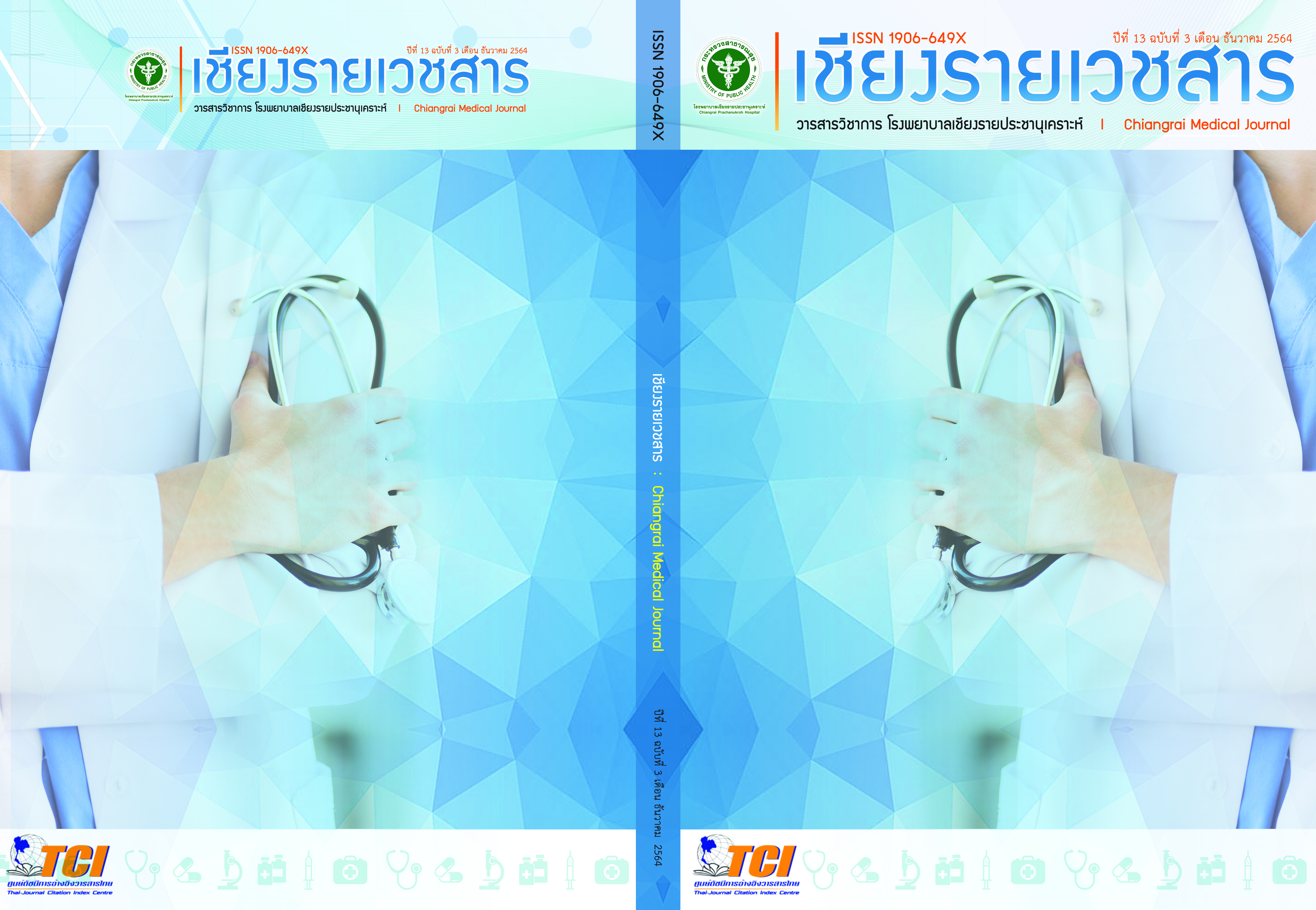การเปรียบเทียบประสิทธิภาพของยาขยายหลอดลมระหว่างวิธีสูดพ่นทางปากร่วมกับกระบอกพ่นยาและแบบสูดพ่นฝอยละอองในผู้ป่วยโรคปอดอุดกั้นเรื้อรังที่มีอาการกำเริบเฉียบพลัน ณ ห้องฉุกเฉินโรงพยาบาลเชียงรายประชานุเคราะห์
Main Article Content
บทคัดย่อ
ความเป็นมา ผู้ป่วยโรคปอดอุดกั้นเรื้อรังที่มีอาการกำเริบเฉียบพลันมักจะเข้ารับการรักษาที่ห้องฉุกเฉินด้วยอาการหายใจหอบเหนื่อย ผู้ป่วยเหล่านี้จะได้รับการรักษาด้วยยาขยายหลอดลมชนิดสูดพ่นฝอยละออง จากสถานการณ์การแพร่ระบาดของโรคโควิด 19 มีคำแนะนำให้ใช้ยาขยายหลอดลมโดยวิธีสูดพ่นทางปากร่วมกับกระบอกพ่นยาแทน แต่ปัจจุบันการศึกษาประสิทธิภาพของการรักษาทั้ง 2 วิธียังมีการเปรียบเทียบไม่ชัดเจน
วิธีการศึกษา เป็นการศึกษาแบบเก็บข้อมูลย้อนหลังในผู้ป่วยโรคปอดอุดกั้นเรื้อรังที่มีอาการกำเริบเฉียบพลันและเข้ารับการรักษาในห้องฉุกเฉินตั้งแต่วันที่ 1 ตุลาคม 2562 ถึง 31 มีนาคม 2564 แบ่งผู้ป่วยออกเป็นสองกลุ่ม ได้แก่กลุ่มที่ได้รับยาขยายหลอดลมชนิดพ่นฝอยละอองและกลุ่มที่ได้ชนิดสูดพ่นทางปากร่วมกับกระบอกพ่นยา วิเคราะห์ความสัมพันธ์กับผลลัพธ์ทางคลินิกระหว่างผู้ป่วยทั้งสองกลุ่มด้วย multivariable regression
ผลการศึกษา ผู้ป่วยโรคปอดอุดกั้นเรื้อรังที่มีอาการกำเริบเฉียบพลันจำนวน 645 รายแบ่งเป็น กลุ่มที่ได้รับยาขยายหลอดลมชนิดสูดพ่นทางปากร่วมกับกระบอกพ่นยาจำนวน 339 ราย และกลุ่มที่ได้รับยาขยายหลอดลมชนิดพ่นฝอยละอองจำนวน 306 ราย ภายหลังการวิเคราะห์พหุหลายระดับพบว่า กลุ่มที่ได้รับยาขยายหลอดลมชนิดสูดพ่นทางปากร่วมกับกระบอกพ่นยา มีโอกาสนอนโรงพยาบาล 1.11 เท่า (95% CI 0.92 – 1.33, p-value 0.273) โอกาสการใส่ท่อช่วยหายใจ 1.07 เท่า (95% CI 0.44-2.61, p-value 0.887) โอกาสการกลับมาตรวจซ้ำภายใน 48 ชั่วโมง 0.38 เท่า (95% CI 0.16-0.95, p-value 0.038) และระยะเวลาเฉลี่ยของการนอนโรงพยาบาลมีความแตกต่างกัน -1.85 ชั่วโมง (95% CI -11.18 – 7.47, p-value 0.697)
สรุปผลและข้อเสนอแนะ การใช้ยาขยายหลอดลมชนิดสูดพ่นทางปากร่วมกับกระบอกพ่นยาเปรียบเทียบกับยาขยายหลอดลมชนิดพ่นฝอยละอองในผู้ป่วยโรคปอดอุดกั้นเรื้อรังที่มีอาการกำเริบเฉียบพลันมีประสิทธิภาพไม่แตกต่างกัน แต่การใช้ยาขยายหลอดลมชนิดสูดพ่นทางปากร่วมกับกระบอกพ่นยาช่วยลดโอกาสกลับมาตรวจซ้ำภายใน 48 ชั่วโมง และสามารถนำไปใช้เป็นแนวทางในการใช้ยาขยายหลอดลมในการรักษาผู้ป่วยโรคปอดอุดกั้นเรื้อรังที่มีอาการกำเริบเฉียบพลันที่มาห้องฉุกเฉินได้
Article Details
เอกสารอ้างอิง
Thoracic Society of Thailand under Royal Patronage. Recommendation for COPD management 2017. Bangkok: Beyond Enterprise; 2017.
Wittayanukullack A. Information on chronic obstructive pulmonary disease: Health Region 1, round 2/2020 [Internet]. Chiang Mai: Health Region 1; 2020 [cited 2021 May 7]. Available from: https://www.chiangmaihealth.go.th/cmpho_web/document/200816159755596654.pdf. (in Thai)
Jinjeeranun T. A summary report of inspection and job supervision in normal case, round 2: FY 2020; Health Region 1, Q3 (October 1, 2019 – May 31, 2020) Chiang Mai Province, during June 24 – 25, 2020 [Internet]. Chiang Mai: Health regional 1; 2021 [cited 2021Apr 7]. Available from: https://www.chiangmaihealth.go.th/cmpho_web/document/200620159262924773.pdf. (in Thai)
Kopsaftis ZA, Sulaiman NS, Mountain OD, Carson-Chahhoud KV, Phillips PA, Smith BJ. Short-acting bronchodilators for the management of acute exacerbations of chronic obstructive pulmonary disease in the hospital setting: systematic review. Syst Rev. 2018;7(1):213
Global strategy for prevention, diagnosis and management of chronic obstructive pulmonary disease (2020 Report). Hadfield R, Hess M, editors. Global Initiative for Chronic Obstructive Lung Disease; 2020.
Silairatana S. Conclusion and recommendation in COPD management during COVID 19 pandemic [Internet]. Bangkok: Thoracic Society of Thailand under Royal Patronage; 2020 [cited 2021 Oct 27]. Available from: https://www.thoracicsocietythai.org/2020/05/17/tst-assembly-recommendations-covid19/. (in Thai)
Cazzola M, Ora J, Bianco A, Rogliani P, Matera MG. Guidance on nebulization during the current COVID-19 pandemic. Respir Med.2021;176:106236.
Amirav I, Newhouse MT. Transmission of coronavirus by nebulizer: a serious,underappreciated risk. CMAJ. 2020;192(13):E346.
Ari A. Practical strategies for a safe and effective delivery of aerosolized medications to patients with COVID-19. Respir Med. 2020;167:105987.
Koh HP, Shamsudin NS, Tan MMY, Mohd Pauzi Z. The outcomes and acceptance of pressurized metered-dose inhaler bronchodilators with venturi mask modified spacer in the outpatient emergency department during the COVID-19 pandemic. J Clin Pharm Ther. 2021;46(4):1129-38.
Khoo SM, Tan LK, Said N, Lim TK. Metered-dose inhaler with spacer instead of nebulizer during the outbreak of severe acute respiratory syndrome in Singapore. Respir Care. 2009;54(7):855-60.
Berry RB, Shinto RA, Wong FH, Despars JA, Light RW. Nebulizer vs spacer for bronchodilator delivery in patients hospitalized for acute exacerbations of COPD. Chest. 1989;96(6):1241–6.
Shortall SP, Blum J, Oldenburg FA, Rodgerson L, Branscombe JM, Harrow EM. Treatment of patients hospitalized for exacerbations of chronic obstructive pulmonary disease: comparison of an oral/metered-dose inhaler regimen and an intravenous/nebulizer regimen. Respir Care. 2002;47(2):154-8.
Sorino C, Negri S, Spanevello A, Visca D, Scichilone N. Inhalation therapy devices for the treatment of obstructive lung diseases: the history of inhalers towards the ideal inhaler. Eur J Intern Med. 2020;75:15-8.
Benge CD, Barwise JA. Aerosolization of COVID-19 and Contamination Risks During Respiratory Treatments. Fed Pract. 2020;37(4):160-3.
Taffet GE, Donohue JF, Altman PR. Considerations for managing chronic obstructive pulmonary disease in the elderly. Clin Interv Aging. 2014;9:23-30.


